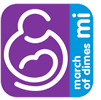Common Pregnancy and Maternity Terms
Amniocentesis
A test in which a small amount of fluid is removed from the amniotic sac surrounding the fetus using a needle. It can detect genetic characteristics evidence of infection or lung maturity of the fetus.
Amniotic sac
When women refer to their “water breaking” they’re referring to a rupture of the amniotic sac, which is formed to two thin membranes that contain a watery liquid called amniotic fluid that can tear before delivery or be torn to hasten labor. The fetus grow inside the sac. Â
Apgar score
A 1 to 10 rating doctors give to newborns at one minute and five minutes after delivery to assess color, heart rate, muscle tone, respiration and reflexes. The higher the score, the better.
Braxton Hicks contractions
False labor pains.
Breech
The position of the fetus when its head is up and its buttocks or feet are down, and would be delivered feet-first or buttocks first.
Chorionic villus sampling (CVS)
A small sample of chorionic villi are taken from the placenta where it meets the uterus and are tested for chromosomal and other abnormalities.
Dilation
The diameter of the cervical opening.
Doppler
A form of ultrasound that reflects motion-such as the fetal heartbeat-in the form of audible signals.Â
Doula
A labor coach trained to help a pregnant women through childbirth, assisting with breathing and relaxation techniques, massage, guiding women through labor positions, encouragement and reassurance.Â
Electronic fetal monitor
An electronic instrument used to record the heartbeat of the fetus and contractions of the mother’s uterus.
Embryo
The developing fertilized egg of early pregnancy.
Epidural
An anesthetic given often to women in labor that numbs the lower half of the body to reduce the pain of delivery.
Episiotomy
A surgical incision made into the perineum (the region between the vagina and the anus) to widen the vaginal opening during delivery. Â
Fetus
The unborn baby growing in a woman’s uterus after the first eight weeks of pregnancy.
Follicle-stimulating hormone
A hormone produced by the pituitary gland that helps stimulate eggs to mature and be released by the ovaries for fertilization.
Forceps
An obstetrical instrument used during delivery that fits around the head of the fetus during labor to guide it through the birth canal.
Gestational diabetes
A form of diabetes that develops during pregnancy and results in the improper regulation of glucose levels in the blood.Â
Glucose challenge test
A test that screens for gestational diabetes by measuring a woman’s blood sugar level after drinking a glucose solution.Â
Human chorionic gonadotropin (HCG)
Hormone produce during pregnancy; level of this hormone are used in all pregnancy tests.
Induction
Artificially starting labor-often by administering medication or breaking the bag of water- to stimulate contractions.Â
In-vitro fertilization
Process by which eggs and sperm are combined in an artificial environment outside the body, then transferred back into a woman’s uterus to grow.
Lamaze
Techniques used by the mother during childbirth that can reduce pain and limit the need for pain medication during pregnancy.
Midwife
A certified, registered nurse whose specialty is caring for women and their babies from early pregnancy through delivery and the weeks after birth. To become a certified midwife, a person must complete an accredited nursing program, have a graduate degree in midwifery, pass a national exam and maintain nursing license. Midwives also must work with a qualified doctor who provides backup support.
Neural tube
Structure in the embryo that develops into the brain, spinal nerves and backbone one.
Placenta
The circular, flat organ that’s responsible for oxygen and nutrient exchange and the elimination of waste products between the mother and the fetus.
Postpartum depression
Intense feelings of sadness, anxiety, or despair that can afflict a mother after childbirth and can affect a woman’s ability to function.
Preeclampsia
A condition that occurs during pregnancy and is marked by high blood pressure and protein in the urine.
Sources: “Your Pregnancy & Birth, Fourth Edition” by the American College of Obstetricians and Gynecologists and the “Mayo Clinic Guide to a Healthy Pregnancy”.
initiatives
Calhoun County Home Visiting Programs
The Period of PURPLE Crying
Fetal Infant Mortality Review
Infant Child
Lead Information
Community Partners





















